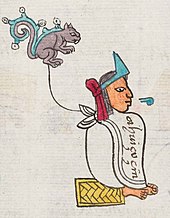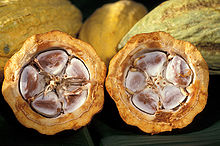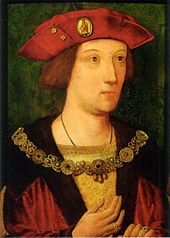1502
Portal history | Portal Biographies | Current events | Annual calendar | Daily item
◄ |
15th century |
16th century
| 17th century
| ►
◄ |
1470s |
1480s |
1490s |
1500s
| 1510s
| 1520s
| 1530s
| ►
◄◄ |
◄ |
1498 |
1499 |
1500 |
1501 |
1502
| 1503
| 1504
| 1505
| 1506
| ►
|►►
| 1502 | |
|---|---|
| Moctezuma II becomes ruler of the Aztecs . | Albrecht Dürer draws his nature study of the brown hare . |
|
Alberto Cantino sends the Cantino Planisphere from Portugal to the Duke of Ferrara . |
|
| 1502 in other calendars | |
| Armenian calendar | 950/951 (turn of the year July) |
| Ethiopian calendar | 1494/95 |
| Aztec calendar | 9th house - Chicuhnahui Calli (until the end of January / beginning of February: 8th Feuerstein - Chicuei Tecpatl ) |
| Buddhist calendar | 2045/46 (southern Buddhism); 2044/45 (alternative calculation according to Buddhas Parinirvana ) |
| Chinese calendar | 69th (70th) cycle
Year of the Water Dog壬戌 ( at the beginning of the year metal rooster 辛酉) |
| Chula Sakarat (Siam, Myanmar) / Dai calendar (Vietnam) | 864/865 (turn of the year April) |
| Dangun era (Korea) | 3835/36 (October 2-3) |
| Iranian calendar | 880/881 |
| Islamic calendar | 907/908 (turn of the year 6/7 July) |
| Jewish calendar | 5262/63 (September 2/3) |
| Coptic Calendar | 1218/19 |
| Malayalam calendar | 677/678 |
| Seleucid era | Babylon: 1812/13 (turn of the year April)
Syria: 1813/14 (turn of the year October) |
| Spanish era | 1540 |
| Vikram Sambat (Nepalese Calendar) | 1558/59 (turn of the year April) |
events
Politics and world events
Voyages of discovery
The Fourth Voyage of Christopher Columbus
- February 26th: Christopher Columbus asks Ferdinand of Aragón and Isabella of Castile for a fleet for another trip to America, on March 14th the expedition is approved by the royal family .
- May 9 or May 11: In Cádiz , Christopher Columbus sets off on his fourth journey to the New World . His fleet consists of four caravels with a transverse mainsail , the flagship Capitana , the La Gallega , the Santiago de Palos and the Vizcaína with a total of more than 120 men on board.
- July 30th: On his fourth voyage, Christopher Columbus sets foot on the Caribbean island of Guanaja near the north coast of what is now Honduras . He then sails along the Central American mainland coast between Honduras and Panama.
- August 14: Columbus sets foot on the American mainland for the first time near Cape Honduras .
- October 5th: Christopher Columbus names a discovered country Costa Rica y Castillo de Oro , because locals gave him gold chips.
- November 2nd: On his fourth voyage, Christopher Columbus reaches a bay in what is now Panama , which he attests to be a beautiful harbor . The city of Portobelo will later develop there .
Vasco da Gama's second trip to India

- The fourth Portuguese voyage to India is again under the command of Vasco da Gamas after he protested to his childhood friend, King Manuel I , against a renewed appointment of Pedro Álvares Cabral as commander in chief of the fleet. This time he leaves with 21 heavily armed ships. On the outward journey he is already setting up bases in East Africa , including in Sofala .
- Vasco da Gama discovered the Seychelles archipelago on his second trip to India and called them Ilhas do Almirante ( Admiral Islands ).
- The appearance of the Portuguese in the Indian Ocean and their attack on the trade monopoly of Arab and Indian traders led to a latent state of war. Immediately after his arrival in Indian waters off Calicut, Vasco da Gama had to face a fleet of more than 100 Indian and Arab, mostly smaller ships, which the Portuguese squadron wanted to intercept. Avoiding boarding combat and through their effective gunfire, the Portuguese were able to almost completely destroy the enemy fleet. Negotiations, the exploitation of rivalries among the Indian princes and the ruthless use of force succeed in breaking the resistance of the Indian princes promoted by the Arab traders. Vasco da Gama is consolidating Portugal's position on the Indian Malabar coast by further expanding and strengthening the Portuguese factories in Cannanore and Cochin .
More voyages of discovery
- January 1st: The Portuguese navigator Gaspar de Lemos arrives at a bay in Brazil that the locals call Guanabara Bay . He himself thinks it is a river, which, according to the date, he calls Rio de Janeiro .
- May 21: The Portuguese navigator João da Nova discovers the island of St. Helena in the South Atlantic on his way back from India .
Kingdom of England
- April 2: The English heir to the throne Arthur Tudor dies just four months after his marriage to Katharina von Aragón at the age of 15 from an unknown illness. His younger brother Heinrich becomes the new Crown Prince .
Spain and its colonies
- February 13: Under the command of Antonio de Torres , an experienced captain who accompanied Christopher Columbus on his second voyage, Sanlúcar de Barrameda casts the largest fleet that has set sail for the New World by then . In addition to the new governor Nicolás de Ovando, around 2,500 colonists, who are hand-picked to represent a representative cross-section of Spanish society, will be transported on the roughly thirty ships . Among them are the Dominican and later chronicler Bartolomé de las Casas , the discoverer of Florida , Juan Ponce de León , and the later conqueror of Peru, Francisco Pizarro . The fleet reached Hispaniola on April 15th . In the first few months, hundreds of settlers perish from the hardships that life in the colonies brings with it - the unfamiliar climatic conditions, the unknown diseases and, last but not least, the generally prevalent deficiency. The Indians, who were arbitrarily forced into forced labor under the viceroyalty of Columbus, are increasingly getting on fire by fleeing into the mountains and hiding there.
- February 14: The Catholic Kings order the baptism or expulsion of all Muslims from the Kingdom of Granada by the end of March.
Papal States
- June 21: The Pope's son Cesare Borgia drives out Duke Guidobaldo I da Montefeltro and his wife Elisabetta and occupies his Duchy of Urbino during his third campaign in Romagna . On July 20th he conquered Camerino through treason and had Duke Giulio Cesare da Varano arrested and murdered.
- August 18: Leonardo da Vinci becomes chief engineer of the Papal States' troops under Cesare Borgia .
- Autumn: Opponents of the Borgia meet in Magione on Lake Trasimeno for a secret meeting, but split up on October 9th without agreeing on a common strategy.
- December 31: At a reconciliation ceremony in Senigallia with four of his opponents, Cesare Borgia had two murdered immediately, the other two arrested first and then murdered two weeks later.
Holy Roman Empire

Landsknecht Joß Fritz initiated a Bundschuh movement in Bruchsal and Untergrombach . The places belong to the diocese of Speyer , whose bishop Ludwig von Helmstatt financed expensive buildings by increasing taxes and restricting the forest, pasture and fishing rights of his subjects. The articles of the Bundschuh movement demand the abolition of serfdom, the abolition of tithes and other customs duties, the elimination of noble privileges in the use of forests and fishing grounds, and the confiscation of a large part of the monasteries. The movement soon includes at least 7,400 people in the area between the Main and Neckar. Initially the occupation of Untergrombach and then a train to the margraviate of Baden are planned , but the movement will be betrayed in disregard of the confessional secret. Joß Fritz escapes, but 110 members are caught. Ten farmers are beheaded, quartered and hung on the country roads as a deterrent.
Northern and Eastern Europe
- June: The Crimean Tatars under Meñli I. Giray defeat the Namagan patrimony , the remaining rump state of the Golden Horde under their last Khan Shaykh Ahmad .
- September 13: In Livonia , the Livonian Confederation and the Teutonic Order under Grand Master Wolter von Plettenberg win the Battle of the Smolina Sea over the army of the Grand Duchy of Moscow under Daniel Vasilyevich Shtschenja and thus decide the Russo-Lithuanian war against Ivan III. for themselves.
- Ivan III At the insistence of his second wife Sofia Palaiologa, he has his grandson and possible heir to the throne Dimitri from his first marriage and his wife Helena arrested.
Aztec Empire
- Moctezuma II becomes the new ruler of the Aztecs after the death of his uncle Auítzotl . During the first seventeen years of his rule, he continued the rigid expansion policy of his predecessors.
business
- The Land Book of Hof is the first property register of the Hof office as part of the Margraviate of Brandenburg-Kulmbach .
science and technology
- July 6th: At the instigation of Elector Friedrich III. of Saxony, the Roman-German King Maximilian I granted the imperial founding privilege for the Alma Mater Leucorea , which opened on October 18 as the first university after the partition of Leipzig in the Ernestine Electorate of Saxony . The first rector is Martin Pollich , the first dean of the theological faculty Johann von Staupitz , the first chancellor Goswin von Orsoy .
- Amerigo Vespucci sends the travelogue Mundus Novus to the Florentine nobleman Lorenzo di Pierfrancesco de 'Medici . In it he describes his third trip to South America, which lasted from May 1501 to September 1502.
- November 19: The diplomat Alberto Cantino secretly sends the so-called Cantino-Planisphere from Portugal to Ercole I. d'Este , Duke of Ferrara . The planisphere is a world map that contains the latest cartographic knowledge from the last few years. It contains the earliest directly dated map representation of America , but not yet given that title.
Culture and society
- February 2nd: Alfonso I d'Este , eldest son of Duke Ercole I d'Este of Ferrara , Modena and Reggio , marries Lucrezia Borgia , daughter of Pope Alexander VI. and sister Cesare Borgias .
- February 13: The Spanish Dominican Bartolomé de Las Casas , later the most important critic and chronicler of the Conquista , travels to the West Indies in today's Caribbean for the first time to settle in Hispaniola .
- Albrecht Dürer draws his nature study of the brown hare .
- Christopher Columbus, and with him Europe, got to know the cocoa bean from the Mayans .
- Vasco da Gama's expedition made the acquaintance of the Ceylon cinnamon tree and with it cinnamon on Ceylon .
religion
- July 28: The Danzig Marienkirche , one of the largest churches in Europe, is completed. Heinrich Ungeradin is named as the builder .
- July 29th: Matthias Scheit resigns from his office as Bishop of Seckau . He did this under pressure from Maximilian I, who wanted Christoph von Zach as his successor and had him succeeded. Scheit is granted the right to a new successor.
Born
January to May
- January 7th: Ugo Boncompagni, as Gregor XIII. Pope († 1585)
- January 13: Anton Lauterbach , German Lutheran theologian and reformer († 1569)
- February 2: Damião de Góis , Portuguese diplomat and historian († 1574)
- February 25: Alfonso d'Avalos , Italian prince, lord of Ischia and Procida († 1546)
- March 4: Elisabeth of Hesse , Hereditary Princess of Saxony († 1557)
- March 18: Philibert de Chalon , Prince of Orange, Duke of Gravina, Count of Tonnerre and Charny and Lord of Arlay and Nozeroy († 1530)
- March 20: Pierino Belli , Piedmontese soldier and lawyer († 1575)
- April 2: Susanna of Bavaria , Princess of Bavaria-Munich and by marriage successively Margravine of Brandenburg-Kulmbach and Countess Palatine von Neuburg († 1543)
- April 10: Ottheinrich , Elector Palatinate († 1559)
- April 25: Georg Major , German Lutheran theologian († 1574)
- May: Jakob Bagge , Norwegian naval officer and admiral in the Swedish Navy († 1577)
June to December
- June 2: Guillaume Bigot , French poet, philosopher and doctor († around 1550)
- June 6th: Johann III. , King of Portugal († 1557)
- June 26: Cristóbal de Rojas y Sandoval , Bishop of Oviedo, Bishop of Badajoz, Bishop of Cordoba and Archbishop of Seville († 1580)
- July 26: Christian Egenolff , German printer († 1555)
- July 27: Francesco Corteccia , Florentine organist, conductor and composer († 1571)
- August 4th: Pieter Coecke van Aelst , Flemish painter († 1550)
- September 14: Ludwig II , Count Palatine and Duke of Pfalz-Zweibrücken, Count of Veldenz († 1532)
- October 15: Nikolaus Medler , German Lutheran theologian and reformer († 1551)
- October: Justinian von Holzhausen , Mayor of Frankfurt am Main († 1553)
- December 6th: Anna von Braunschweig-Lüneburg , Duchess of Pomerania († 1568)
- December 6: Nikolaus Gentzkow , German lawyer and chronicler, Mayor of Lüneburg († 1576)
- December 13th: George III. , Landgrave of Leuchtenberg († 1555)
Exact date of birth unknown
- Heinrich Aldegrever , German engraver († 1555/61)
- Johannes Anglicus , Protestant theologian and hymn composer († 1577)
- Borommaracha IV. , Twelfth king of the Siamese Empire of Ayutthaya († 1533)
- Giacomo Chizzola , judge and diplomat in Brescia († 1580)
- István Dobó , Hungarian soldier and castle captain († 1572)
- Johannes Garcaeus the Elder , German Lutheran theologian and reformer († 1558)
- Johannes Hagemeister , German theologian († 1569)
- Janusz III. , Duke of Mazovia († 1526)
- Miguel López de Legazpi , Spanish conquistador († 1572)
- Blaise de Montesquiou , French historian, army commander and Marshal of France († 1577)
- Pedro Nunes , Portuguese mathematician and astronomer († 1578)
- Gonzalo Pizarro , Spanish conquistador († 1548)
- Narcissus Renner , Augsburg illuminator († 1536)
- Johannes Stomius , German musician, educator, humanist, Latin poet († 1562)
- Bálint Török , Hungarian magnate, general, Ban von Nándorfehérvár and lord of the Csesznek Castle († 1551)
- Tsharchen Losel Gyatsho , Tibetan Buddhist monk and monastery founder († 1566)
- Jakub Uchański , Archbishop of Gniezno and Primate of Poland († 1581)
- Benedetto Varchi , Florentine poet and historian († 1565)
- Antonio Maria Zaccaria , founder of the Italian order and Catholic saint († 1539)
- Christoph von Zedtwitz , German nobleman and soldier († 1575)
- Mordechai Zemach , Prague Jewish printer († 1591)
Born around 1502
- Johannes von Heppenheim called from the hall , canon in Speyer and Worms († 1555)
- Johannes Kessler , German Reformed theologian and chronicler († 1574)
- Jorge Reinel , Portuguese cartographer († around 1572)
- Francesco Spiera , Italian Protestant legal scholar († 1548)
Died
First half of the year
- after January 17th: Johann Koelhoff the Younger , German printer and publisher of the incunable period
- January: Johannes Mauburnus , Flemish Augustinian canon, theologian and author of the edification (* around 1460)
- February 18: Hedwig Jagiellonica , also known as "Jadwiga", Polish princess, Duchess of Bavaria-Landshut (* 1457)
- around March 14: Felix Fabri , German Dominican and writer (* 1438/39)
- April 2: Arthur Tudor , Prince of Wales, Crown Prince of England (* 1486)
- May 4th: Berthold II. Von Landsberg , Bishop of Verden and Hildesheim (* before 1454)
- June 5: Georg I. Göler von Ravensburg , German nobleman (* 1440)
- June 6: Heinrich Brömse , Mayor of Lübeck (* 1440)
Second half of the year
- July 15: Vincenz Lang , German humanist and poet
- July 20: Giovanni Battista Ferrari , Bishop of Modena (* 1450)
- August 7th: Ursula von Rammung , founder and lady of the Kraichgau nobility
- August 18th: Knut Alvsson , Norwegian knight and landowner
- August 22nd: Frans van Busleyden , Burgundian politician and Archbishop of Besançon
- September 1: Iio Sōgi , Japanese Buddhist monk and Renga poet (* 1421)
- before September 20: Albrecht Dürer the Elder , goldsmith in Nuremberg (* around 1427)
- October 20: Konrad Summenhart , German theologian, canonist and natural philosopher (* around 1450)
- November 8th: Kaspar zu Rhein , Prince-Bishop of Basel (* 1433)
- November 10: Georg I , Duke of Münsterberg and Oels, Count of Glatz (* 1470)
- November 11th: Hans Bär the Elder , Basel merchant and changer (* 1465)
- November 13: Annius von Viterbo , Italian Dominican and forger of historical documents (* around 1432)
Exact date of death unknown

- Auítzotl , ruler of the Aztecs
- Francisco de Bobadilla , Spanish colonial administrator, coroner and governor of the West Indies
- Diogo Gomes , Portuguese explorer and author (* 1420)
- Georg Gossembrot , Augsburg merchant, financial advisor to Maximilian I (* around 1445)
- Andreas Laer van Deventer , provost of the Augustinian monastery in Bordesholm
- Francesco Laurana , Italian sculptor, architect, painter and medalist of Croatian origin (* 1430)
- Olivier de la Marche , Burgundian writer and general mint master of Geldern (* around 1425)
- Andreas Palaiologos , titular emperor of Byzantium and titular despot of Morea (* 1453)
- Thonis von Palant , Herr von Reuland, Monschau and Neersen (* between 1431 and 1446)
- Werner Rolevinck , Carthusian monk from Cologne and writer (* 1425)
- Octavien de Saint-Gelais , French cleric, poet and translator (* 1468)
- Giulio Cesare da Varano , Italian condottiere and Duke of Camerino (* 1430)
Died around 1502
- Nicolò Alunno , Italian painter (* around 1430)








